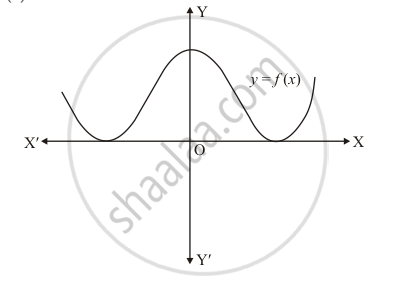Advertisements
Advertisements
प्रश्न
If fourth degree polynomial is divided by a quadratic polynomial, write the degree of the remainder.
उत्तर
Here `f (x)` represent dividend and g(x) represent divisor.
`g (x)` =quadratic polynomial
`g(x)= ax^2 + bx + c`
Therefore degree of `(f(x))=4`
Degree of `(g(x))= 2`
The quotient q(x) is of degree `2 (=4-2)`
The remainder `r (x)` is of degree 1 or less.
Hence, the degree of the remainder is equal to 1 or less than 1
APPEARS IN
संबंधित प्रश्न
Classify the following polynomials as polynomials in one-variable, two variables etc:
`t^3_3t^2+4t-5`
In Q. No. 15, write the sign of c.
The graph of a polynomial f(x) is as shown in Fig. 2.21. Write the number of real zeros of f(x).

If f(x) = x3 + x2 − ax + b is divisible by x2 − x write the value of a and b.
If α, β are the zeros of the polynomial f(x) = x2 + x + 1, then \[\frac{1}{\alpha} + \frac{1}{\beta} =\]
If the diagram in Fig. 2.22 shows the graph of the polynomial f(x) = ax2 + bx + c, then

Identify the following expression is polynomial. If not give reason:
`1/(x^(-2)) + 1/(x^(-1)) + 7`
Case Study -1

The figure given alongside shows the path of a diver, when she takes a jump from the diving board. Clearly it is a parabola.
Annie was standing on a diving board, 48 feet above the water level. She took a dive into the pool. Her height (in feet) above the water level at any time ‘t’ in seconds is given by the polynomial h(t) such that h(t) = -16t2 + 8t + k.
A polynomial q(t) with sum of zeroes as 1 and the product as -6 is modelling Anu’s height in feet above the water at any time t( in seconds). Then q(t) is given by ______.
An asana is a body posture, originally and still a general term for a sitting meditation pose, and later extended in hatha yoga and modern yoga as exercise, to any type of pose or position, adding reclining, standing, inverted, twisting, and balancing poses. In the figure, one can observe that poses can be related to representation of quadratic polynomial.


The graph of parabola opens downwards, if:
Classify the following as a constant, linear, quadratic and cubic polynomials:
`sqrt(2)x - 1`
